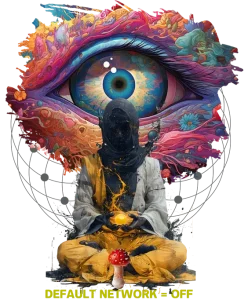Introduction
In recent years, the combination of psychedelics and virtual reality (VR) has emerged as a groundbreaking approach in mental health treatment. This innovative therapy leverages the therapeutic benefits of psychedelics with the immersive capabilities of VR, creating a powerful tool for addressing various psychiatric disorders, including treatment-resistant depression, post-traumatic stress disorder (PTSD), and anxiety disorders. This article delves into the synergistic potential of psychedelics and VR, highlighting their combined effects and practical applications in therapeutic settings.
The Evolution of Psychedelic Therapy
Historical Context
Psychedelics have been used for centuries in different cultural and spiritual contexts. However, it wasn’t until the mid-20th century that their therapeutic potential began to be scientifically explored. Despite promising results, research on psychedelics was largely halted in the 1970s due to regulatory restrictions. In recent decades, there has been a resurgence of interest, with numerous studies demonstrating the efficacy of psychedelics in treating a variety of psychiatric disorders, including treatment-resistant depression and PTSD.
Modern Research and Applications
Current studies have shown that psychedelics can induce significant therapeutic effects, particularly in treatment-resistant depression, PTSD, and anxiety disorders. These substances, including classic psychedelics like psilocybin and lysergic acid diethylamide (LSD), work by disrupting the brain’s default mode network, leading to enhanced neuroplasticity and altered states of consciousness. The therapeutic potential of psychedelics is now being explored in combination with other innovative technologies, such as VR.
The Role of Virtual Reality in Therapy
What is Virtual Reality?
Virtual reality is a computer-generated environment that allows users to interact with and experience a three-dimensional world. By using VR headsets and sensory inputs, users can immerse themselves in a variety of simulated environments. VR is a powerful tool for creating therapeutic settings because it allows for controlled, immersive, and safe environments.
VR in Mental Health Treatment
VR has been increasingly used in mental health treatments, offering unique advantages such as controlled exposure therapy for phobias, relaxation training, and social skills training for individuals with autism spectrum disorder. Its ability to create safe, immersive, and controlled environments makes it an ideal complement to psychedelic therapy. VR can enhance therapeutic experiences by providing structured yet flexible frameworks for emotional and psychological exploration.
Combining Psychedelics with VR: The Synergy
Enhanced Therapeutic Experiences
The combination of psychedelics and VR can amplify the therapeutic effects of both modalities. Psychedelics can enhance the immersive experience of VR, making therapeutic simulations more vivid and impactful. For example, a VR environment designed to simulate a calming nature scene can be experienced more profoundly when under the influence of a psychedelic, potentially leading to deeper emotional and psychological healing.
Addressing Treatment-Resistant Conditions
Many mental health conditions, such as treatment-resistant depression and PTSD, do not respond well to conventional therapies. The synergistic effects of psychedelics and VR can offer new hope for these patients. By breaking down psychological barriers and facilitating new perspectives, this combined approach can lead to significant improvements in mental health. Psychedelic-assisted therapy, when combined with VR, can create a supportive and immersive environment that helps patients navigate complex emotional landscapes.
Practical Applications and Case Studies
Case Study: Treating PTSD
One notable application of psychedelics and VR is in the treatment of PTSD. Traditional exposure therapy can be enhanced by using VR to recreate traumatic scenarios in a controlled and safe environment. When combined with psychedelics, patients can process traumatic memories more effectively, leading to reduced symptoms and improved coping mechanisms. Virtual reality exposure therapy (VRET) has been shown to provide a sense of presence and agency, which, when coupled with the dissociative effects of psychedelics, can help patients confront and reframe traumatic experiences.
Case Study: Alleviating Depression
In cases of severe depression, VR can create positive, uplifting environments that, when paired with psychedelics, help patients break free from negative thought patterns. For instance, a patient might explore a serene virtual forest or a calming beach, facilitating a profound sense of peace and well-being. The use of virtual reality experience in psychedelic sessions can enhance the therapeutic outcomes by providing a structured yet flexible framework for emotional exploration.
Enosis Therapeutics: Pioneering Psychedelic VR Therapy
Enosis Therapeutics is at the forefront of combining psychedelic compounds with VR for therapeutic use. By integrating VR into psychedelic-assisted psychotherapy, they aim to enhance the therapeutic process and improve treatment outcomes for a range of mental disorders. This innovative approach involves using VR to guide patients through their psychedelic experiences, providing a supportive and immersive environment that can help them navigate complex emotional landscapes.
Challenges and Considerations
Safety and Ethical Concerns
The combination of psychedelics and VR is not without its challenges. Ensuring the safety and ethical treatment of patients is paramount. This includes obtaining informed consent, managing potential adverse reactions, and ensuring that sessions are conducted by trained professionals. Adverse effects and psychological side effects must be carefully monitored, especially considering the heightened suggestibility and vulnerability of patients under the influence of psychedelics.
Integration into Clinical Practice
Integrating this novel approach into mainstream clinical practice requires overcoming regulatory hurdles and developing standardized protocols. This involves extensive training for therapists, rigorous clinical trials, and clear guidelines to ensure patient safety and treatment efficacy. The integration process must also consider the potential for adverse reactions and the need for robust support systems to manage these effectively.
Future Directions and Research
Expanding Applications
The potential applications of psychedelics and VR in therapy are vast. Future research could explore their use in treating a broader range of conditions, such as obsessive-compulsive disorder (OCD), eating disorders, and chronic pain. Additionally, developing personalized VR environments tailored to individual therapeutic needs could enhance treatment outcomes.
Long-Term Effects and Sustainability
Long-term studies are needed to understand the sustainability of the therapeutic benefits of combining psychedelics and VR. This includes examining the longevity of symptom relief and the potential for any long-term adverse effects. Future studies should also investigate the psychological effects and integration process to ensure that patients derive lasting benefits from their psychedelic experiences.
Conclusion
The integration of psychedelics and virtual reality represents a promising frontier in mental health treatment. By harnessing the therapeutic potential of these two modalities, therapists can offer more effective and immersive treatments for a range of psychiatric disorders. As research continues to evolve, this innovative approach may become a cornerstone of future mental health care.
Combining psychedelic-assisted therapy with VR not only enhances the therapeutic process but also offers a new dimension of treatment for conditions such as PTSD, depression, and anxiety disorders. As the field progresses, the potential for positive outcomes and therapeutic effects continues to grow, making this an exciting area of development in modern psychotherapy. With ongoing research and development, the combination of these cutting-edge therapies holds the promise of transforming the landscape of mental health treatment.
In conclusion, the synergy between psychedelics and virtual reality offers a novel and potentially transformative approach to mental health therapy. By providing immersive, controlled, and supportive environments, this combination can enhance the therapeutic effects of both modalities, offering new hope for individuals struggling with a variety of psychiatric conditions. As research and clinical practice continue to advance, the integration of these technologies promises to revolutionize the field of mental health care, paving the way for more effective and comprehensive treatments.


